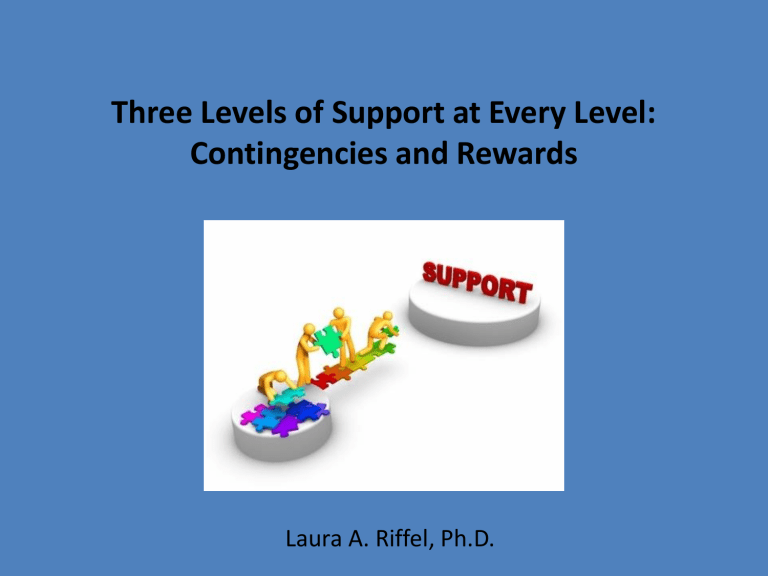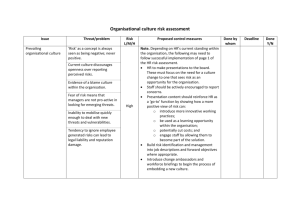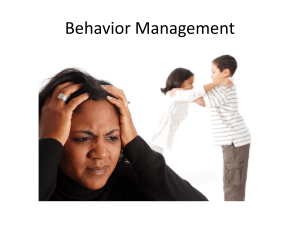Group Contingencies and Group Rewards

Three Levels of Support at Every Level:
Contingencies and Rewards
Laura A. Riffel, Ph.D.
What is a group contingency?
• In this context, we are referring to some pretext where all the students are working together to earn a group reward.
• Similar to big business, if we meet our sales quota we’ll take the team to
Hawaii. (Only, we don’t get to go to
Hawaii)
Remember
• Energy flows where attention goes- you want to use this to point out appropriate behavior in the classroom.
• Every time you notice the classroom exhibiting good behavior have someone add a point or a piece to the group contingency focus piecewhen the piece is mastered- the class gets the agreed upon reward.
Caveats
• Daily
• Weekly
• Monthly
Whole School
Triplicate Gotchas
Verbal and
Physical Behavior
Specific Praise with each gotcha
Verbal, behavior specific praise and save for points to cash in for prizes
Recognition
Drawing for Prizes
(Daily)
Weekly prizes at
Friday Assembly
Parent Training
• Train parents what they should do when their child comes home with a gotcha:
– High five
– Behavior Specific Praise
– Help them generalize
• “ What did ‘Respect Others’ look like?”
• “What would that look like in the grocery store?”
– Give parents a copy of 100 ways parents can reward their children at home for having good behavior at school (free)
Classroom (Homeroom)
• Teacher does three things:
– Records the gotcha on a free tool available on www.behaviordoctor.org
(Gotcha Tracking Tool)
• This is kept on the universal drive so support staff can look to see who needs to be “caught”
– Gives behavior specific praise when appropriate
• Some students do not like public praise
– Develops a filing system for the students to keep their gotchas until they cash them in
Principal
• Principal does four things:
– Drawing every day for a prize- at least three names
• Renting the principal’s chair
• Homework pass
• Gets to read the announcements the next day
– Gives prizes each Friday for class, student, and teacher who earned or gave out the most gotchas
– Calls parents for every 25 th gotcha (stamped on the back)- Positive phone call home and get to dance with the principal in the front office.
– Uses data to determine when double gotcha day should be the next week
• Whatever day was the most difficult each week will be the day of the week all staff wear their school shirts-
• Gotchas given that day are worth two points
Group Contingency= Group Reward
Lunchroom
Classroom that is the quietest gets to go outside first- it’s a few extra minutes of recess. (Elementary)
Classroom that is the quietest gets to sit at special table on the stage the next day or bring I-pods the next day (Secondary)
Lunch staff add popsicle sticks to library pockets as they catch tables being quiet.
The table with the most popsicle sticks on
Thursday gets to choose what teachers and what dance. The next day, those teachers have to perform the dance during lunchtime (lipsync)
Tardies to class
Principal sets up a quick survey in the computer lab for what type of music the students like.
Principal plays 4 minutes of student music between classes over the school intercoms
Principal plays 1 minute of
“polka” music the last minute of class changing time.
If tardies stay below 98% it stays this ratio- otherwise it flips 4 minutes of “polka” music.
Special Classes in Elementary
Give “Golden” or
“Platinum” awards for best in the class.
Giving a “gotcha” to a whole class-
TRANSITIONAL
Secondary
Bragging Rights- Homework Free Night
Class with the most “Gotchas”
Earns a prize-
Elementary-
Secondary- use homeroom
Bus with the most “gotchas” wins reward
Reward happens at school- this gives the message that bus and school are working together and one in the same.
Classroom Ideas
Daily
• Each teacher should have three levels of contingencies and rewards-
– Daily
– Weekly
– Monthly
Put Mr. Potato Head Together
Put the cootie together.
Don’t think this is just an elementary idea.
Even high school students will have good behavior if the reward is right – They will just want to make the cootie bug more bizarre looking
Stacking Ring
Pot Holder Loops
• As you catch students exhibiting appropriate behavior, take one of these out of your pocket and say, “thank you for being respectful (or whatever the behavior was)”. At the end of class, count the total number of loops given out. If the predetermined number of loops are reached the class earns a whole class reward.
Weekly
Barrel of Monkeys
Connect 4 Launchers
Draw a student each time you notice the class working nicely.
They launch one circle. It either lands on the top level or the bottom level. The class gets a reward when they get four in a row of a color. There could be two rewards- red reward and yellow reward. Whichever color makes four in row first is the reward the class earns.
Matching
You could make your own matching cards or use commercial matching cards. Put velcro or magnets on the front side of the cards so they stick to the white board. This could be Pre-K through high school level. When you notice the class working quietly choose a student to come up and flip over two cards so the class can see what they are.
When someone makes a match the class gets a reward.
When the marbles fall- class prize
Week Long Contingency
I’d velcro the board and pieces up on the white board so the students can see where they are in the game.
Besides a daily contingency- you could have a weekly contingency going for things like bringing back homework, everyone having a pencil, everyone in their seat when the bell rings, things like that – each one worth a few jumps on the game board. (any game board- even high school students would be nostalgic for Candy Land)-
When they reach the end of the game board they earn a home work free night. Incidentally, this is the number one thing secondary students tell me would mean the world to them. One night without home work means more to them than any monetary or tangible object you could give them.
Chutes and Ladders
Same concept as Candy
Land- All of the students working together for a group pay off.
Compliment Board
1111 1111 1111 1111
1111 1111
From the dollar store
Weaving good behavior in the classroom
Brownie Points
Monthly
2 jars- one w/lights & one w/out
Ways to Choose Prizes
Make your own scratch-off prizes
Two parts model paint to one part dishwashing detergent.
Here’s my suggestion- On tag board make your bubble letters and then write a prize in each bubble letter.
Laminate the tag board.
Then paint over the laminated letters. This way you can reuse it year after year.
Otherwise, the student will scratch too hard and you won’t be able to use it again.
Label Noodles “A” and “B” – put prizes on board for
“A” and “B” and then choose two students to start marbles on command. Class gets prize of whichever marble makes it first.
Mystery Motivator
Students flip over letters as they get caught exhibiting excellent behavior- trying to figure out what they are earning. Kind of like “Wheel of Fortune”
Write prizes on a CD- choose student to spin.
• Spin the wheel
Individual Contingency-
Individual Reward
This can be used for students who are working on individualized behavior plans
Bracelets
• Using pot holder loops or silly bands from Oriental Trading Company or similar- work out a contract with the individual student.
• 10 bracelets equals a break or 5 bracelets equals a break
– Be specific- what behaviors will they have to exhibit to earn a bracelet – tell them in measurable and observable terms, so they can visualize.
– Never take away a bracelet once it’s earnedjust don’t give one when they are exhibiting inappropriate behavior.
For older students
• Points- work fine
• The Boystown® Model works well with students with emotional behavior issues.
• Based on 100 points per day
– For more information:
• http://www.boystown.org/education
Play on Interests
• Legos- 10 Lego blocks put together equals a break or a prize
• The Lego can be kept on the teacher’s desk so they are not a distraction use a special color at the top so the student knows when they have reached the goal. You might even put glitter on the top Lego.
Simple is Best
Now/Then or First/Then
Simple- earning computer time
Best One
• The next one works with 4 year olds to 18 year olds
• It’s research based
Student-Teacher Rating Form
Date:
Student
Respect
Self
Respect
Others
Respect
Property
Total
Points
Hour One Hour Two Hour Three Hour Four Hour Five Hour Six
3= Great Hour- No or very few behavioral learning opportunities occurred
2= Pretty Good Hour- few behavioral learning opportunities occurred
1= This Hour could have been better- more than a few behavioral learning opportunities occurred
Student Signature: _________________________________________________
Teacher Signature: _________________________________________________
Parents' Signature: _________________________________________________
For younger students use smiling faces:
John Hattie
• Visible Learning: A Synthesis of Over
800 Meta-Analyses Relating to
Achievement- Available at www.amazon.com
• Found that students recording their own success had the highest impact.
When paired with a relationship building activity it becomes an even stronger intervention.
Dr. Ann Corvin says these 3 things are essential to building a relationship:
– Eye contact
– Touching
– Talking
Bhaerman, R.D. & Kopp, K.A. (1988) says:
– A student is less likely to drop out of school if one adult other than their teacher knows and uses their name.
• By tying in Dr. Leanne Hawken’s Behavior
Education Program (Check-in/Check-out a school can use both components of monitoring their own progress and tying in Dr. Ann
Corvin’s research and Drs. Bhaerman and
Kopp’s research with her unique way of checking in on a student on an hourly and daily basis.
• To read more about the Behavior Education
Program check out this article: http://www.calstat.org/textAlt/SpEDge_eng/fall
05edge.html
Earned reward
End of day check-out with preferred adult
Check in-
Check out
Morning check-in with preferred adult
Review points
Hourly teacher evaluation
Graph points
Hourly teacher evaluation
Mid-day check in with preferred adult Graph points Adapted from
Hawken 2008
Family and School Partnerships are
Important
•
•
•
•
•
•
•
•
•
•
•
Christenson, S. L. (1995). Families and schools: What is the role of the school psychologist? School Psychology Quarterly, 10, 118-132.
Clark, R.M. (1990). Why disadvantaged students succeed: What happens outside school is critical. Public Welfare (17-23).
Epstein, J.L. (1991). Paths to partnership: What can we learn from federal, state, district, and school initiatives. Phi Delta Kappa, 72 (5) .
Henderson, A. & Mapp, K. (2002). A new wave of evidence: The impact of school, family, and community connections on achievement. Austin, TX: National Center for Family
& Community Connections with Schools.
Hoover-Dempsey, K.V., Whitaker, M.C., & Ice, C.L. (2010). Motivation and commitment to family-school partnerships. In S.L. Christenson & A.L. Reschly (Eds.),
Handbook of school-family partnerships ( pp. 30-60). New York: Routledge.
Jeynes, W. H. (2005). A meta-analysis of the relation of parental involvement to urban elementary school student academic achievement. Urban Education, 40, 237-269.
Jeynes, W. H. (2007). The relationship between parental involvement and urban secondary school student achievement: A meta-analysis. Urban Education, 42, 82-110.
Marzano, R. J. (2003). What works in schools: Translating research into action.
Alexandria, VA: Association for Supervision and Curriculum Development.
Sheridan, S.M. (1997). Conceptual and empirical bases of conjoint behavioral consultation. School Psychology Quarterly, 12, 119-133 .
I tie my student/teacher rating sheet into the home
•
The parents reward the students at home for good behavior at school.
• This does several things:
– Connects home and school in a positive way instead of an adversarial way.
– Sends message to student that home and school are working together.
– Student gets rewarded and recognized for good behavior which encourages good behavior
– Parents are happy to comply with something so simple
– Rewards are attention and recognition- not prizes.
This is how an intervention works- research based not punishment based.
1. Student measuring progress
2. Teaching expectations
3. Monitoring expectations
4. Relationship building
(teacher/student)
5. Keeping a student in school
6. Building connections between home and school





